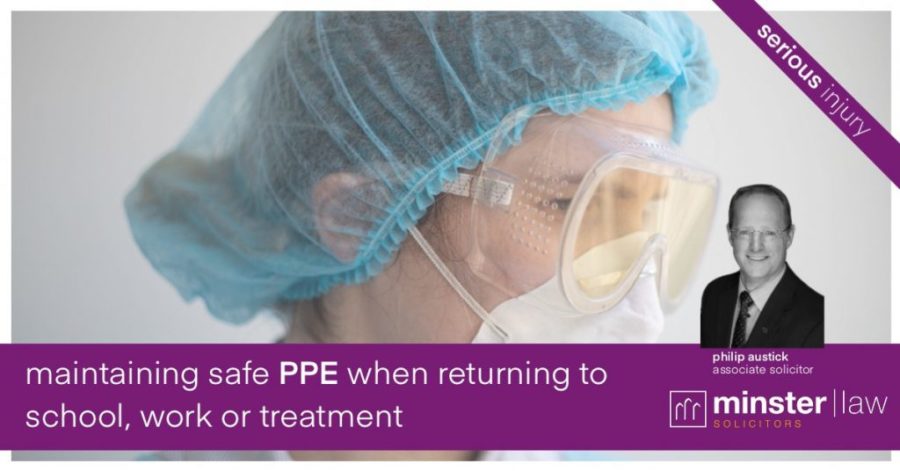Maintaining safe PPE when returning to school, work or treatment


Across the country students are returning to schools, employees are back in offices, stores and restaurants are opening, and face masks are becoming a common sight.
Minster Law represent a large number of seriously injured and vulnerable clients – currently some of them or their families are among those coming out of lockdown, returning to work or school or restarting treatment for their injuries.
Associate solicitor Philip Austick provides some insight into Personal Protective Equipment (PPE) and how our clients can best protect themselves in these changing times.
PPE is the equipment intended to be worn or held by a person which protects them against one or more risks to their health or safety.
The concept of PPE is nothing new – the introduction of the Personal Protective Equipment at Work Regulations 1992, came into place in 1983 and since then employers have had to ensure suitable PPE is provided to its workforce.
In light of Covid-19 PPE has become a household term.
Following the global pandemic, it has become a feature both in and out of the workplace and the government, through Public Health England, continue to publish and update guidelines on keeping safe.
With people returning to work or using public transport, with shops and restaurants reopening and the return of face to face meetings it is important that safety remains paramount.
Not only is it important to safeguard yourself and your own family, but for those you may come into contact with.
Part of this is informing others if you feel you may be developing or have symptoms which could put them at risk of contracting Covid-19.
There may still be challenges in a face-to-face assessment or therapy as it is recognised individuals may be subject to risk of transmission
The NHS has issued guidelines for its healthcare workers, including therapists, for providing care and treatment to vulnerable people, or where anyone in the household is vulnerable.
Disposable plastic aprons, surgical masks, gloves and eye protectors may be worn for the protection of both the individual and the healthcare provider when visiting you at home or in a clinical setting.
While in communal waiting areas or if using public transportation, it is recommended that individuals wear a surgical face mask if this can be tolerated.
The aim of this is to reduce both direct transmission risk and environmental contamination.
It is possible a face mask may not be worn if there is potential for their care to be compromised – for example, when receiving oxygen therapy via a mask.
A face mask can be worn until damp or uncomfortable, thereafter non-disposable masks should be washed thoroughly and disposable ones safely disposed of.
As a means of reducing the risks further, particularly at home, limiting treatment to one room in the home, which may be used for treatment purpose only, where it is possible.
Also ensuring the room is well ventilated and reducing the number of visitors before and after therapy is recommended.
Hygiene is always important but showering or bathing before and after each therapy session would be wise.
The essentials of a safe return to work is paramount, not only to all individuals, but especially to those who are vulnerable or are living with or caring for anyone who is vulnerable.
Recommended measures for employers before reopening a workplace include:
– Carrying out a Covid-19 risk assessment
Before restarting work, you should ensure the safety of the workplace by carrying out a proper and effective risk assessment and sharing the result.
– Developing cleaning, hand washing and hygiene procedures
Encourage people to follow the guidance on hand washing and hygiene, provide hand sanitiser around the workplace, frequently clean and disinfect objects and surfaces that are touched regularly.
– Support and encourage where possible working from home
The employer should discuss home working arrangements, ensuring staff have the right equipment, and looking after their physical and mental well being while they work from home.
– Maintain 1m social distancing where possible
Put up signs to remind workers and visitors of social distancing guidance, avoid sharing workstations, use floor tape or paint to mark areas to help people keep a 1m distance, arrange one-way traffic through the workplace if possible, switch to seeing visitors by appointment only.
– Where people cannot be 1m apart, manage transmission risk
Consider whether an activity needs to continue for the business to operate, keep the activity time involved as short as possible, use screens or barriers to separate people from each other, use back-to-back or side-to-side working whenever possible, stagger arrival and departure times, reduce the number of people each person has contact with.
Check in with your employer which steps they have taken before returning to work, to ensure your safety.
Those who are self-employed must consider the risks of entering customers premises and ensuring own safety by ascertaining if the customer or any member their household is self-isolating or has been exposed to the virus.
If there is a risk, then the assessment should include a decision whether the risk can be avoided with suitable PPE or should be re-scheduled.
Most, if not all NHS Trusts, have issued specific guidance for procedures to be followed when attending clinic appointments.
The same will apply when returning to medical appointments or for reviews of medico-legal appointments.
It is recommended prior to each visit to check with the hospital on their updated procedures and guidelines.
Most appointments are offered in the settings of a private hospital and so adherence to their procedures will need to be followed and guidelines updated on their websites.
In the context of a medico-legal setting, many experts have been able to offer appointments via videoconferencing where it has been possible to assess clients without a physical examination so as to reduce significant delay in diagnosing and reporting brought about by the Covid-19 lockdown.
Face to face meetings are likely to slowly return over the coming months where these are required.
It is now law that people must wear a face covering when travelling on public transport in England.
This includes travelling on a bus or coach, train or tram, ferry or hovercraft, or any other vessel, including aircraft.
The penalty for not wearing a face covering, at the time of publishing, could be a fine of £100, or £50 if paid within 14 days.
A face covering is described as a covering of any type which covers your nose and mouth.
You should also wear a face covering in other enclosed spaces where it is difficult to maintain social distancing – for example, at stations, interchanges, ports and airports, or in taxis and private hire vehicles.
A taxi driver or private hire vehicle operator may be entitled to refuse to accept you if you do not wear a face covering.
For more information on how Minster Law has been keeping cases moving during lockdown click here.